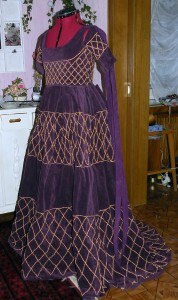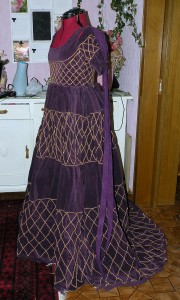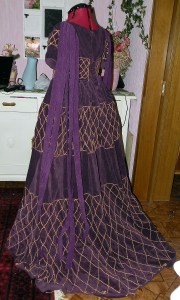I have to admit that I was obsessed with this gown from the moment I saw it in the Cast Courts of London’s Victoria and Albert Museum.
I spent a lot of research on it after returning from my trip, and eventually even made a sculpture for SecondLife that looked like the tomb. Then, one day, I thought it was finally time to make the gown in RL.
Let’s for a moment get back to the original gown, as shown on the tomb.
This gown really existed in Beatrice’s closet; she wore it for the baptism ceremony of her son.
The original gown was made of burgundy velvet, with golden cords and silver tassles. Unfortunately, there’s no record as to what the ‚ribbon cloak‘ (the ribbons that fall from the back of her shoulders to the floor) would be made from; and as I am writing this, I’m still thinking about what material to make them from.
I think burgundy velvet ribbons could be nice. Or maybe satin? Golden (as in: metallic golden) ribbons seem to be out of question, since that, in my opinion, would look cheap.
Well, I’ll decide upon the ribbons when I get to them, I guess 😉 Anyway, the one thing I started with was to take one of the pics of the tomb and overlay it with a grid:
You will notice that I’ve cut the picture to ’shoulder to feet‘. I then assumed that this ’shoulder to feet‘ would be my own size, which would be 145cm.
I then created the grid, of which every red square repesents 10x10cm. This way I was able to achieve exact measurements for my own dress; such as the size of the ‚diamond net‘ patterns formed by the twisted cords, the length of the tassles or as the distance between the ’netted‘ and ’non-netted‘ parts on the skirt.
Proportionally, Beatrice’s body is a tad different from my own; but just having vague measurements already helps.
Also, I took this picture:
and, as you can see, traced the exact line of the skirt hem with Photoshop.
I them resized the pic to make it fit the ’scale grid‘ pictures above, and, using Photoshop’s path and measurement tools, measured the hem line.
From that measurement, in relation to the „my size“ grid height, I calculated that the hem on Beatrice’s skirt must be 454cm wide – that helps immensely to make a working pattern!
From this picture:
as well as the ‚grid‘ picture above you can perfectly see how the pleating on the skirt is done.
There’s a large pleat at the center front, turned towards the sides and there are three pleats at the front sides, turned towards the front.
From knowing this I started draping a bodice and skirt pattern on my dress mannequin; using a well drapeable rayon taffeta which will later serve as the lining of the gown:
Note that in these pics, only *half* of the skirt is draped. As in: The front right and the back right sides.
By doing so, I can just iron the pleats that I’ve pinned and after that it’s much easier to mirror those pleats to the other side.
Also note that the final neckline isn’t cut yet. It’s just drawn to the fabric, which isn’t really visible in these pics.
Here’s a picture of the fabric I’ll use; burgundy red cotton velveteen (that’s cotton velvet with an extremely short pile, in case you didn’t know) before the inevitalbe washing before sewing.
And here’s a pic of the same velvet after the first washing and a short dye:
Cording on the front of the dress in progress:
The cording of the front part of the skirt is finished (That’s over 60 meters / 66 yards of cording so far!):
Here’s a comparison of the cording on the statue’s dress with the cording on my skirt:
Cording of the upper back part of the skirt finished – that’s another 30 meters / about 33 yards of cording. Note that the back portion of the skirt is actually *double as wide* (approximately 2.8m / 3 yards) as the front portion (which is approximately 1.4m / 1 1/2 yards wide); it’s just (much!) pleated at the back waist:
Now on to cording the lower back part of the skirt, which, as you can probably see and because of the train, is going to be more than double as high as the upper back cording. This basically means that I assume that this lower back portion of the skirt will take another approximately 80 meters / 88 yards of cording.
By the way, by now I’m close to having used 100 meters / 110 yards of cording on this dress – which is the amount that I *initially* thought to be enough for the *entire* dress! *LOL!
Cording of the skirt, bodice AND sleeves finished. Also, I partially assembled the dress – and already added the ribbons that fall from the back of her sleeves to the ground. Note that the front of the skirt is already sewn to the bodice, while the cartridge-pleated back is just pinned (so it looks weird):





I love your dress! I have a strong pull to all things Beatrice d’Este and found your page while trying to find out where her tomb is. Your photos of the tomb cast are great and your dress is just amazing! I wish I had talent like that (or the money to buy it from you 🙂 )
Thank you 🙂
Hi
I enjoy very much you job. I live in Milan so you can imagine how delighted I am with Sforza’s history.
I need to precise that are not ribbons those are hanging from the back. Actually is a cloak with the edges cut with frappature or frastagli.
I’m not quite sure about the ribbons.
As you’ve probably seen, I’ve based my studies on the cast of Beatrice’s marble tomb at the V&A, which is a pretty exact replica (after all, it’s been cast from the original tomb, so it should be! 😉 ).
When studying that cast tomb, I saw something on those ribbons that looked like, well, „ribbon edging“ (opposed to fabric being secured because of slashing / cutting). That’s why I’ve always thought of them being ‚ribbons‘, not slashed / cut fabric.
Also, Beatrice’s love for ribbons is pretty well-known; just look at some of her other portraits – those show a usage of ribbons on clothing that I have never seen in anyone else’s portrait.
Then again we’ll probably never know for sure, since, after all, it’s just a marble tomb (albeit a magnificient one!) and even if it’s the most detailled marble statue dress I’ve ever seen, neither I nor you can outrule artistic license / freedom taken by Solari when he created the tomb.
So unless someone discovers and shows the extant dress, we’ll never know for sure about the actual fabrics, colors, and / or ribbons or slashed cloak 😉
Thank you for your lovely site. You are very talented and I loved your instructions for making the ermine. I wish that I was able to sew well as you. I’m 60 and have been sewing since I was about 12, but I just can’t find the time to do it as much as I would like. I also love your doll clothes. I’m trying to make a medieval or Renaissance doll for my 7 year old granddaughter. I’ve saved your page as one of my favorites. I live in Houston Texas and my name is Jan. Thanks again.
Jan Aronson
Houston, Texas
What a beautyful dress you have made! Fantastic! I found your pictures when i was searching for pictures of Beatrice d’Este. I’m reading a historic novel about her and I can really recommend the book. Duchess of Milan by Michael Ennis. He describes everything in detail., so you can imagine everything. Houses, dresses, juwelleries, everything. Read the book if you want to know Beatrice. I think he has caught her just right.
What a joy it was to discover your site this morning! Thank you for the photographs and for pointing out the details in Beatrice’s costume.
I have become enamoured by Beatrice d’Este, and I’m not sure why. It’s partly due to her spiritedness. On a recent trip to Venice, I sat in the hotel dining room and from across the room I noticed the profile of a woman carved into the fireplace mantel. I recognized her immediately as our subject here. I touched it in awe. That night, as I lay in bed, I could not get her out of my mind, so I dressed and went to the hotel computer in the lobby to research whether she had been in Venice? Yes, indeed, she had visited, and she had been received with great ceremony. Had she stayed at this particular place?
None of the historic hotel staff knew why her profile was on the mantel piece.
An elderly woman in the dining room one evening observed me once again touching the image. She approached me and said that she was psychic. She said that she had been watching me stare at the image of the woman on the mantle, and that my love of history was a gift and that my connection to Beatrice had a purpose that I was to find out.
Hence, my further research this morning led me to your wonderful site. Would you please show us a few photos of the completed garment?
I will be travelling to England and France in the fall of 2012 with my mother. (I lived in England as a child) I have been contemplating sewing a gown to wear when I visit historical castles, especially those of ancestral importance, so your site is a great inspiration to me.
Thank you again for taking the time to do this site.
Debra Hall
Alberta, Canada
Hi Debra,
thank you for your kind words! If you were coming to Germany, we could meet 😉
I’ll show pictures of the completed gown as soon as I, well, have completed it, which isn’t the case yet. I still need the approximately 200 tassels. Sometimes I just set a costume (like this one) aside for a while, then, when I get the inspiration, continue to work on it 😉
Best wishes,
Naergi